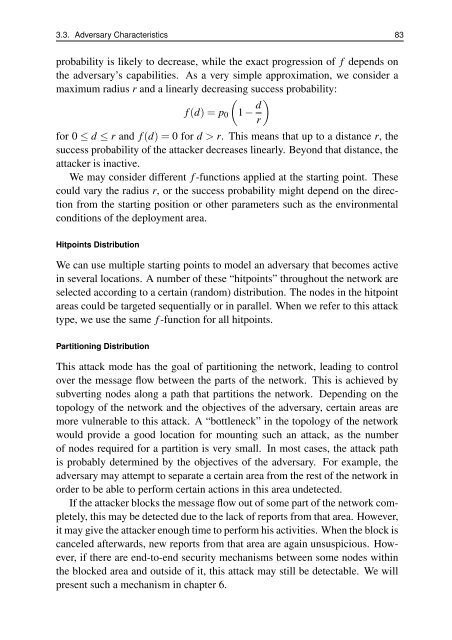Protocols for Secure Communication in Wireless Sensor Networks
Protocols for Secure Communication in Wireless Sensor Networks
Protocols for Secure Communication in Wireless Sensor Networks
You also want an ePaper? Increase the reach of your titles
YUMPU automatically turns print PDFs into web optimized ePapers that Google loves.
3.3. Adversary Characteristics 83<br />
probability is likely to decrease, while the exact progression of f depends on<br />
the adversary’s capabilities. As a very simple approximation, we consider a<br />
maximum radius r and a l<strong>in</strong>early decreas<strong>in</strong>g success probability:<br />
<br />
f (d) = p0 1 − d<br />
<br />
r<br />
<strong>for</strong> 0 ≤ d ≤ r and f (d) = 0 <strong>for</strong> d > r. This means that up to a distance r, the<br />
success probability of the attacker decreases l<strong>in</strong>early. Beyond that distance, the<br />
attacker is <strong>in</strong>active.<br />
We may consider different f -functions applied at the start<strong>in</strong>g po<strong>in</strong>t. These<br />
could vary the radius r, or the success probability might depend on the direction<br />
from the start<strong>in</strong>g position or other parameters such as the environmental<br />
conditions of the deployment area.<br />
Hitpo<strong>in</strong>ts Distribution<br />
We can use multiple start<strong>in</strong>g po<strong>in</strong>ts to model an adversary that becomes active<br />
<strong>in</strong> several locations. A number of these “hitpo<strong>in</strong>ts” throughout the network are<br />
selected accord<strong>in</strong>g to a certa<strong>in</strong> (random) distribution. The nodes <strong>in</strong> the hitpo<strong>in</strong>t<br />
areas could be targeted sequentially or <strong>in</strong> parallel. When we refer to this attack<br />
type, we use the same f -function <strong>for</strong> all hitpo<strong>in</strong>ts.<br />
Partition<strong>in</strong>g Distribution<br />
This attack mode has the goal of partition<strong>in</strong>g the network, lead<strong>in</strong>g to control<br />
over the message flow between the parts of the network. This is achieved by<br />
subvert<strong>in</strong>g nodes along a path that partitions the network. Depend<strong>in</strong>g on the<br />
topology of the network and the objectives of the adversary, certa<strong>in</strong> areas are<br />
more vulnerable to this attack. A “bottleneck” <strong>in</strong> the topology of the network<br />
would provide a good location <strong>for</strong> mount<strong>in</strong>g such an attack, as the number<br />
of nodes required <strong>for</strong> a partition is very small. In most cases, the attack path<br />
is probably determ<strong>in</strong>ed by the objectives of the adversary. For example, the<br />
adversary may attempt to separate a certa<strong>in</strong> area from the rest of the network <strong>in</strong><br />
order to be able to per<strong>for</strong>m certa<strong>in</strong> actions <strong>in</strong> this area undetected.<br />
If the attacker blocks the message flow out of some part of the network completely,<br />
this may be detected due to the lack of reports from that area. However,<br />
it may give the attacker enough time to per<strong>for</strong>m his activities. When the block is<br />
canceled afterwards, new reports from that area are aga<strong>in</strong> unsuspicious. However,<br />
if there are end-to-end security mechanisms between some nodes with<strong>in</strong><br />
the blocked area and outside of it, this attack may still be detectable. We will<br />
present such a mechanism <strong>in</strong> chapter 6.
















